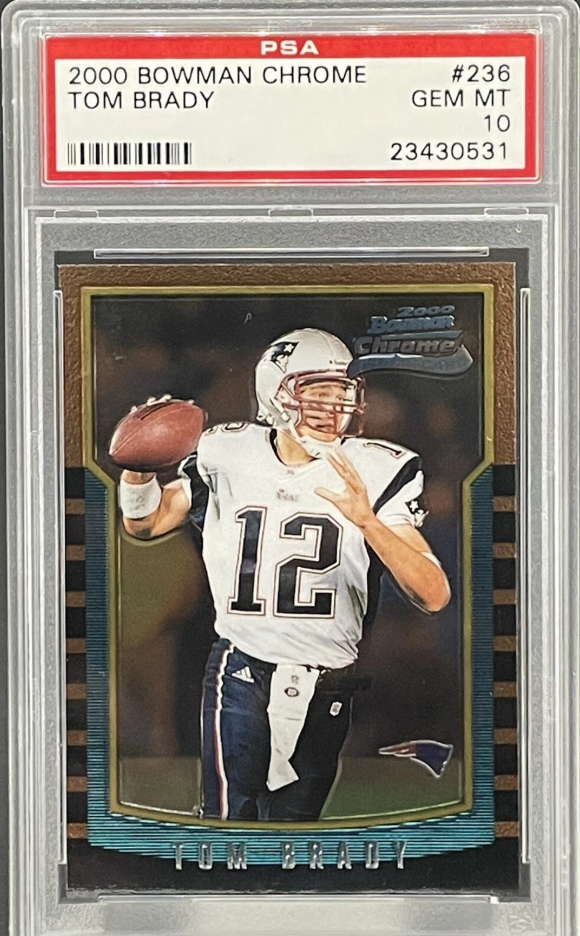In the tapestry of sports memorabilia, some collectibles shine brighter and more enduringly than others, weaving stories that not only capture imaginations but also defy the passage of time. Amidst this captivating world, Tom Brady’s 2000 Bowman Chrome rookie card, particularly Card #236, stands as a steadfast beacon of value and allure. This card, embodying the dazzling rise of a football legend, has lived two hobby lives—initially a hidden gem and later a quintessential reference point in the modern football card market.
To truly appreciate its stature in the collector’s universe, one must peel back the layers of its journey. In the early 2000s, this card was akin to a late-round draft pick tucked away into boxes, waiting to unveil its potential. Fast forward to today, and it occupies a revered spot as the chromium counterpart to its paper Bowman sibling. Its clean, simplistic layout, coupled with a photograph that exudes early New England Patriots aesthetics, complements the glossy finish—a defining characteristic of benchmark rookie cards. It’s designed to catch not only light but also the interest, if not envy, of collectors worldwide.
Diving deeper into the market dynamics, the price rhythm of the Bowman Chrome rookie card has been fascinating to watch. Throughout the summer, PSA 10 graded versions danced around the $10,000 mark, frequently flirting with higher valuations whenever bidding duels ensued. As tracked by Card Ladder, a recent gem breached the $14,000 threshold, and the current spectrum comfortably hovers just above $10,000. This aligns seamlessly with live eBay outcomes and fixed listing prices, crafting a universal narrative where hardcore collectors and casual enthusiasts converse in numbers between ten and fourteen thousand—a sweet spot for any modern football blue chip discussion.
The multitude of sales transactions colors in the background of these figures. A June auction on eBay saw a PSA 10 fetching slightly over $8,000, showcasing a vivid liquidity inherent in this card. Thousands of such sales, spanning various grades, paint a picture of a highly tradable asset. Population reports indicate over 1,200 PSA 10 graded cards in circulation—sufficient supply to maintain fresh comparative analyses week after week, yet limited enough to keep aesthetics and timing crucial in every transaction.
A significant part of its mystique lies in its unassuming design. It doesn’t scream for attention with loud visuals or gimmicks. Instead, it projects a quiet confidence—Tom Brady in his iconic early Patriots gear, captured underneath the chromium film that encapsulates a timeless era. Its straightforwardness averts the mirroring of antiquated designs that plagued many turn-of-the-millennium items. It’s the kind of rookie card that belongs in a gilded frame, gracing walls with its minimalist charm.
While the world of collectibles offers myriad pathways, from paper Bowman alternatives to flashier autographed or low-serial-numbered pieces, conversations invariably loop back to this Chrome card. It distinctly balances recognition, scarcity, and price—a trifecta that appeals to every tier of collector. Casual fans recognize it instantly; dealers can price it instinctively, backed by abundant comparatives, and any list chronicling Brady’s rookie cards by their impact invariably vaults Bowman Chrome to the top.
Condition nuances add another intriguing layer. The usual chromium hurdles—centering and surface—are evident here as well. The value gap between PSA 9 and PSA 10 remains pronounced, impacting both financials and psyche. While nines trade within a narrow corridor, tens command the spotlight. For those eyeing raw versions, vigilance is imperative, examining edges for chips, ensuring surfaces are free from roller lines, and checking that centering doesn’t encroach upon the borders.
For those guided by comparative analytics, the strategy is straightforward. Monitor evening eBay auctions for a pulse on PSA 10s, which predominantly close near the $10,000 mark. Occasionally, competitive bidding propels prices to $12,000 or higher. Utilizing tools like Card Ladder to spot anomalies, such as the $14,000 procurement, serves as a reminder of how a pristine card can indeed ignite a mini-meteor in this vibrant marketplace. The high trading volume of this card negates guesswork, leaning into a rhythm as stable as Brady’s career trajectory.
At the heart of its enduring appeal is the bridging of collector types. Set builders appreciate its foundational role in early Bowman Chrome football. Player collectors cherish it as the truest chromium representation of Brady’s nascent years. Investors are drawn to its known population figures and its proven liquidity. Even those seeking a singular, defining piece of Brady’s legacy inevitably gravitate towards this card, which narrates its tale without the need for elaborate exposition.
For the adventurous, the hunt in the wild still carries hope. Premium tiers in Galaxy Rip Pack sessions sometimes tantalize with this exact card. While inventory rotates and odds remain elusive, the mere possibility electrifies the air, transforming what would be an ordinary evening into one filled with promise.
For those circling slabs with intent, the strategic choice rests between the headline-grabbing power of a PSA 10 or the value-laden charm of a PSA 9. Both come with their own set of benchmarks, trading briskly when aligned with recent data. PSA logs facilitate sanity checks prior to upping the ante.
The big picture is unmistakably clear. This is the modern football rookie card that refuses to fade into obscurity. Its recognition and fluidity are its strongest suits, underpinned by a player career that needed no embellishments. When PSA 10s traditionally move around $10,000 and occasionally spike to $14,000, it underscores a market driven not by hype, but by a seasoned memory. As collectors, whether one prowls through pristine Galaxy Rip Packs, purchases a raw card that gleams under scrutiny, or choose to horde a slab for future nostalgia, they are in pursuit of a collectible moment that resonates deeply, even a quarter-century from inception.

